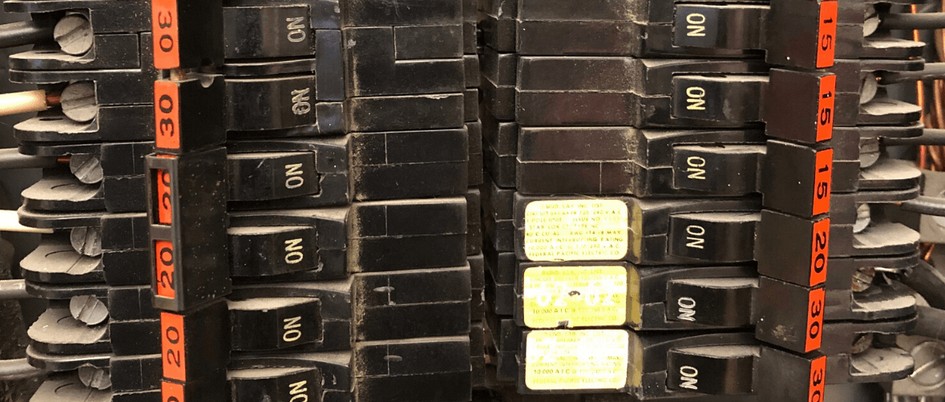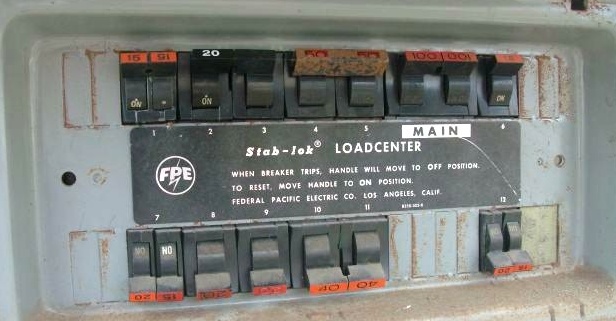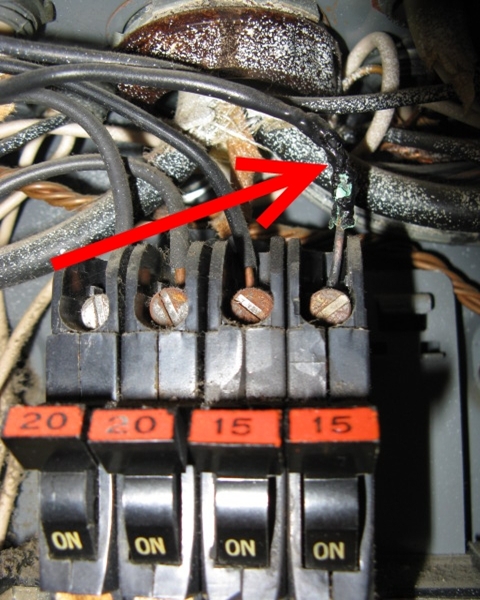Massachusetts Home Inspections YOUR INVESTMENT IS MY CONCERN

Federal Pacific Breakers

There has been considerable discussion about the safety of Federal Pacific Electric (FPE) "Stab-Lok" circuit breakers due to concerns that they may have inherent defects. These defects have been linked to numerous electrical fires in the past. However, no government agency or regulatory authority has officially declared FPE panels unsafe or mandated their replacement, and the Consumer Product Safety Commission has never issued a recall.
The infamous FPE Stab Lok breakers are easy to identify — simply refer to the image above. All FPE breaker panel covers will display the "FPE" and/or "Stab-Lok" logos or insignia. Some breaker handles are orange, while others are black. Most knowledgeable electricians typically recommend replacing FPE panels. Federal Pacific Electric (FPE) "Stab-Lok" circuit breakers were widely installed in homes from the 1950s to the 1980s. However, they have since gained a reputation for potential safety issues. Studies and reports have suggested that these breakers may fail to trip during an electrical fault, increasing the risk of electrical fires.

As a Massachusetts Home Inspector, evaluating FPE breaker panels presents a challenging situation during a whole-house inspection. Visually, these panels often appear to "perform their intended function" at the time of my home inspection. Since the panel itself does not actively present an unsafe condition during my assessment, I am placed in the difficult position of acknowledging the possibility of a latent defect. Despite the absence of immediate issues, the inherent risks associated with FPE panels remain a concern.
The following has been said about Federal Pacific Electric "Stab-Lok" panels:
When the wire insulation began melting, the breaker should have tripped.

If your home has an FPE breaker panel or you're considering to purchase a property with one, I recommend consulting a licensed electrician. They can assess the panel's condition and offer expert advice on the best steps to ensure your home's and family's safety.
Published reports from tests conducted on FPE two-pole 220-volt circuit breakers indicate that, under certain conditions, one leg or pole may attempt to trip while the other remains live. This can result in a compromised breaker that may fail to trip again if exposed to an excessive load. In some cases, breakers have even been known to fall out when the panel cover is removed. Additionally, loose contacts within the panel can cause arcing, which significantly increases the risk of a fire. While these panels often appear to function normally, allowing electricity to flow without noticeable issues, the critical concern remains — how will your panel respond in the event of an overload?

The Consumer Product Safety Commission (CPSC) conducted testing on FPE breakers and found that their failure rates were significant. In response, the CPSC advised consumers to avoid overloading circuits and to turn off and inspect any devices that cause breakers to trip. However, this guidance is impractical and undermines the primary purpose of a circuit breaker — to provide automatic protection in the event of an overload. Federal Pacific's response to these findings was notably cautious, stating that "FPE breakers will trip reliably at most overload levels." The key word here is "most" — noticeably avoiding the assurance that they will trip in all cases.
It's important to note that Federal Pacific is no longer in business. While aftermarket breakers are widely available for FPE panels, most of these panels are large and contain numerous circuits. As a result, the cost of replacing every breaker often exceeds the expense of installing an entirely new panel.
THE SOLUTION
The best solution is to replace the panel entirely. While some companies have started manufacturing replacement breakers for FPE panels, many of these still use the same problematic design as the original, with no evidence to suggest they are more reliable. Additionally, replacing the breakers does not address issues with the bus bars in FPE panels, which, while less documented, can also pose significant risks. In conclusion, any repair or replacement work should only be performed by a licensed electrician to ensure safety and compliance.
Here are some interesting sites relating to this FPE issue...
FPE PANEL TESTS INDICATE FAILURES
GENERAL INFORMATION ON THE FPE PROBLEM
CPSC TEST DATA SHOWING THAT UP TO 2/3 OF FPE BREAKERS FAIL
Here is what my clients have to say about my home inspection services:
Press F5 (on your keyboard) for additional testimonials
I recently accompanied David Valley during his inspection of the house my son was buying. Having purchased a number of houses during my lifetime, I considered myself very knowledgeable and thorough. However, he surpassed me greatly, picking up on important details I would have missed. He frequently suggested ways on how something could be fixed or improved. He displayed broad knowledge of house structure, heating and cooling system, plumbing, electrical, etc. David is the best home inspector I have ever employed and I recommend him implicitly. Thank you for a great home inspection.
Sincerely yours,
Hartmut S.














